Optimization of LFP Pouch Cell Tab Design for Uniform Temperature Distribution
Abstract
1. Introduction
2. Three-Dimensional Electrochemical-Thermal Coupled Model for Large-Format LIB Cell
2.1. Finite Element Model of LIB Cell
2.2. Governing Equations of Electrochemical-Thermal Model
2.3. Validation of Three-Dimensional Electrochemical-Thermal Model
3. Optimization of Uniform Temperature Distribution by Minimizing Difference between Maximum and Minimum Temperatures of LIB Cell
3.1. Design Variables and Response
3.2. Design Optimization Formulation
4. Results and Discussions
5. Conclusions
Author Contributions
Funding
Data Availability Statement
Conflicts of Interest
Nomenclature
| Solid-phase conductivity (S/cm) | |
| Electrical potential (V) | |
| Specific interfacial area (1/cm) | |
| Electrolyte-phase conductivity | |
| Current density (mA/cm2) | |
| Li ion concentration (mol/cm3) | |
| Diffusion coefficient (cm2/s) | |
| Radial coordinate | |
| Transference number | |
| Faraday’s constant (C/mol) | |
| Porosity | |
| Exchange coefficient | |
| SEI layer thickness growth (μm) | |
| Side reaction current density (A/cm2) | |
| SEI layer resistance (Ω cm2) | |
| SEI layer density (kg/cm3) | |
| Cell surface area exposed to convective cooling medium (cm2) | |
| Heat capacity (J/K) | |
| Absolute temperature (K) | |
| Contact resistance (Ω cm2) | |
| Overpotential (V) | |
| Thermodynamic equilibrium potential (V) | |
| Universal gas constant | |
| Exchange current density (mA/cm2) | |
| Current (A) | |
| LIB cell width (mm) | |
| LIB cell height (mm) | |
| Distance from LIB cell edge to nearest corner of positive tab | |
| Distance from LIB cell edge to nearest corner of negative tab | |
| Subscripts and superscripts | |
| Solid phase | |
| Electrolyte phase | |
| Anode | |
| Cathode | |
| SEI | Solid Electrolyte Interphase layer |
| side | Side reaction |
| init | Initial value |
| Effective value | |
| NT | Nominal tab |
| LT | Lateral tab |
| CT | Counter tab |
References
- Barnoon, P. Modeling of a high temperature heat exchanger to supply hydrogen required by fuel cells through reforming process. Energy Rep. 2021, 7, 5685–5699. [Google Scholar] [CrossRef]
- EV OUTLOOK 2021. Progress in EV Sales, Infrastructure Development, and Fleet Expansion. Available online: https://blastpoint.com/wp-content/uploads/2020/02/BlastPoint-2021-EV-Outlook_Report.pdf (accessed on 8 December 2022).
- Pillot, C. Lithium-Ion Battery Raw Material Supply & Demand 2016–2025. In Proceedings of the Advanced Automotive Battery Conference, Mainz, Germany, 30 January–2 February 2017. [Google Scholar]
- Walton, B.; Hamilton, J.; Alberts, G.; Fullerton-Smith, S.; Day, E.; Ringrow, J. Electric vehicles Setting a course for 2030. Deloitte Insights 2020, 15, 1–30. [Google Scholar]
- Lowell, D.; Huntington, A. Electric Vehicle Market Status-Update. Available online: https://mjbradley.com/sites/default/files/EDF_EV_Market_Report_September_2020_Update.pdf (accessed on 8 December 2022).
- Curry, C. Lithium-ion battery costs and market. Bloom. New Energy Financ. 2017, 5, 4–6. [Google Scholar]
- Pang, X.; Huo, Y.; Fang, H.; Rao, Z. Analysis of temperature uniformity of electric vehicle battery system with swirling flow strengthened heat transfer. Appl. Therm. Eng. 2021, 193, 116995. [Google Scholar] [CrossRef]
- Jiang, W.; Zhao, J.; Rao, Z. Heat transfer performance enhancement of liquid cold plate based on mini V-shaped rib for battery thermal management. Appl. Therm. Eng. 2021, 189, 116729. [Google Scholar] [CrossRef]
- Kim, G.-H.; Smith, K.; Lee, K.-J.; Santhanagopalan, S.; Pesaran, A. Multi-Domain Modeling of Lithium-Ion Batteries Encompassing Multi-Physics in Varied Length Scales. J. Electrochem. Soc. 2011, 158, A955–A969. [Google Scholar] [CrossRef]
- Grandjean, T.; Barai, A.; Hosseinzadeh, E.; Guo, Y.; McGordon, A.; Marco, J. Large format lithium ion pouch cell full thermal characterisation for improved electric vehicle thermal management. J. Power Sources 2017, 359, 215–225. [Google Scholar] [CrossRef]
- Kim, H.K.; Kim, C.J.; Kim, C.W.; Lee, K.J. Numerical analysis of accelerated degradation in large lithium-ion batteries. Comput. Chem. Eng. 2018, 112, 82–91. [Google Scholar] [CrossRef]
- Song, W.; Chen, M.; Bai, F.; Lin, S.; Chen, Y.; Feng, Z. Non-uniform effect on the thermal/aging performance of Lithium-ion pouch battery. Appl. Therm. Eng. 2018, 128, 1165–1174. [Google Scholar] [CrossRef]
- Zhu, Y.; Xie, J.; Pei, A.; Liu, B.; Wu, Y.; Lin, D.; Li, J.; Wang, H.; Chen, H.; Xu, J.; et al. Fast lithium growth and short circuit induced by localized-temperature hotspots in lithium batteries. Nat. Commun. 2019, 10, 2067. [Google Scholar] [CrossRef]
- Kim, U.S.; Shin, C.B.; Kim, C.-S. Effect of electrode configuration on the thermal behavior of a lithium-polymer battery. J. Power Sources 2008, 180, 909–916. [Google Scholar] [CrossRef]
- Samba, A.; Omar, N.; Gualous, H.; Capron, O.; Bossche, P.V.D.; Van Mierlo, J. Impact of Tab Location on Large Format Lithium-Ion Pouch Cell Based on Fully Coupled Tree-Dimensional Electrochemical-Thermal Modeling. Electrochimica Acta 2014, 147, 319–329. [Google Scholar] [CrossRef]
- Du, S.; Jia, M.; Cheng, Y.; Tang, Y.; Zhang, H.; Ai, L.; Zhang, K.; Lai, Y. Study on the thermal behaviors of power lithium iron phosphate (LFP) aluminum-laminated battery with different tab configurations. Int. J. Therm. Sci. 2015, 89, 327–336. [Google Scholar] [CrossRef]
- Kosch, S.; Rheinfeld, A.; Erhard, S.V.; Jossen, A. An extended polarization model to study the influence of current collector geometry of large-format lithium-ion pouch cells. J. Power Sources 2017, 342, 666–676. [Google Scholar] [CrossRef]
- Zhang, X.; Chang, X.; Shen, Y.; Xiang, Y. Electrochemical-electrical-thermal modeling of a pouch-type lithium ion battery: An application to optimize temperature distribution. J. Energy Storage 2017, 11, 249–257. [Google Scholar] [CrossRef]
- Mei, W.; Chen, H.; Sun, J.; Wang, Q. Numerical study on tab dimension optimization of lithium-ion battery from the thermal safety perspective. Appl. Therm. Eng. 2018, 142, 148–165. [Google Scholar] [CrossRef]
- Zhao, Y.; Diaz, L.B.; Patel, Y.; Zhang, T.; Offer, G.J. How to Cool Lithium Ion Batteries: Optimising Cell Design using a Thermally Coupled Model. J. Electrochem. Soc. 2019, 166, A2849–A2859. [Google Scholar] [CrossRef]
- Lee, D.-C.; Lee, J.-J.; Kim, J.-S.; Cho, S.; Kim, C.-W. Thermal behaviors analysis of 55 Ah large-format lithium-ion pouch cells with different cell aspect ratios, tab locations, and C-rates. Appl. Therm. Eng. 2020, 175, 115422. [Google Scholar] [CrossRef]
- Lee, J.-J.; Kim, J.-S.; Chang, H.-K.; Lee, D.-C.; Kim, C.-W. The Effect of Tab Attachment Positions and Cell Aspect Ratio on Temperature Difference in Large-Format LIBs Using Design of Experiments. Energies 2020, 14, 116. [Google Scholar] [CrossRef]
- Lee, J.-J.; Kim, J.-S.; Lee, D.-C.; Chang, H.; Kim, C.-W. Design optimization of tab attachment positions and cell aspect ratio to minimize temperature difference in 45-Ah LFP large-format lithium-ion pouch cells. Appl. Therm. Eng. 2021, 182, 116143. [Google Scholar] [CrossRef]
- Doyle, M.; Fuller, T.F.; Newman, J. Modeling of Galvanostatic Charge and Discharge of the Lithium/Polymer/Insertion Cell. J. Electrochem. Soc. 1993, 140, 1526–1533. [Google Scholar] [CrossRef]
- Rao, L.; Newman, J. Heat-Generation Rate and General Energy Balance for Insertion Battery Systems. J. Electrochem. Soc. 1997, 144, 2697–2704. [Google Scholar] [CrossRef]
- Safari, M.; Morcrette, M.; Teyssot, A.; Delacourt, C. Multimodal Physics-Based Aging Model for Life Prediction of Li-Ion Batteries. J. Electrochem. Soc. 2009, 156, A145–A153. [Google Scholar] [CrossRef]
- Guo, G.; Long, B.; Cheng, B.; Zhou, S.; Xu, P.; Cao, B. Three-dimensional thermal finite element modeling of lithium-ion battery in thermal abuse application. J. Power Sources 2010, 195, 2393–2398. [Google Scholar] [CrossRef]
- Yu, S.; Kim, S.; Kim, T.Y.; Nam, J.H.; Cho, W.I. Model Prediction and Experiments for the Electrode Design Optimization of LiFePO4/Graphite Electrodes in High Capacity Ltihium-ion Batteries. Bull. Korean Chem. Soc. 2013, 34, 79–88. [Google Scholar] [CrossRef]
- Venter, G. Review of Optimization Techniques. In Encyclopedia of Aerospace Engineering; John Wiley & Sons, Ltd.: Hoboken, NJ, USA, 2010. [Google Scholar]
- PIDOTECH Inc. PIAnO User’s Manuals and Tutorials; PIDOTECH Inc.: Seoul, Republic of Korea, 2021. [Google Scholar]
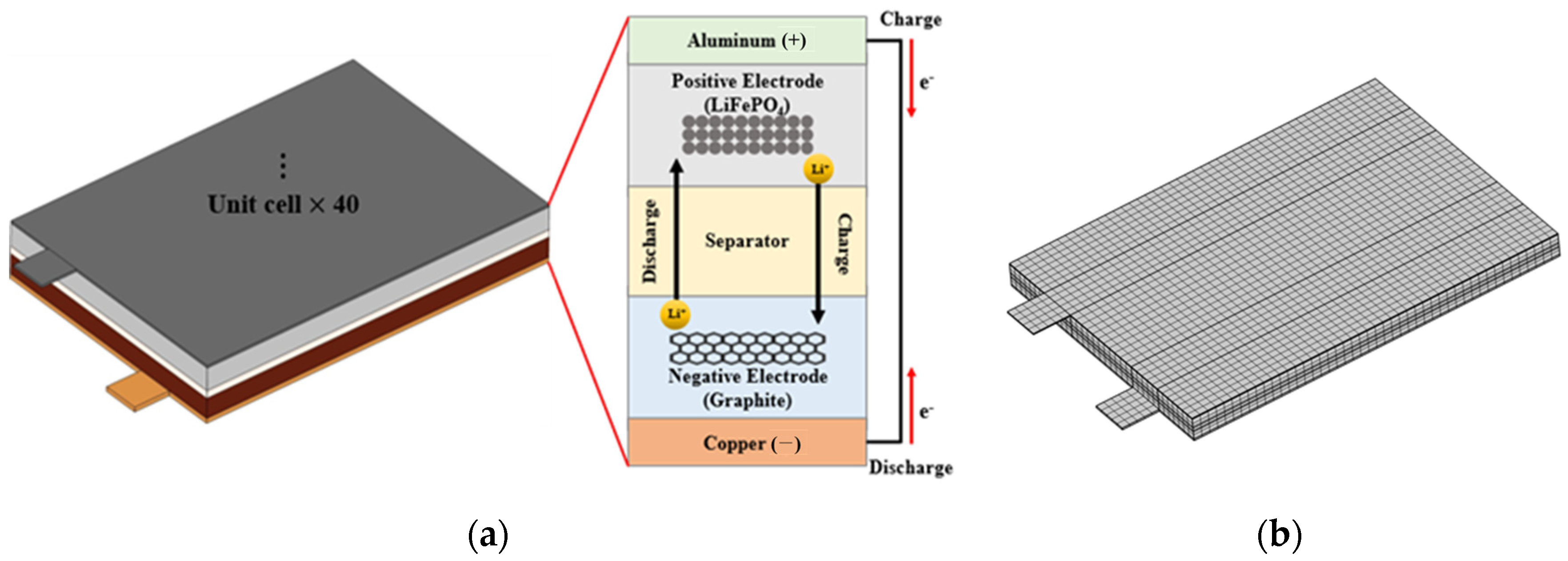
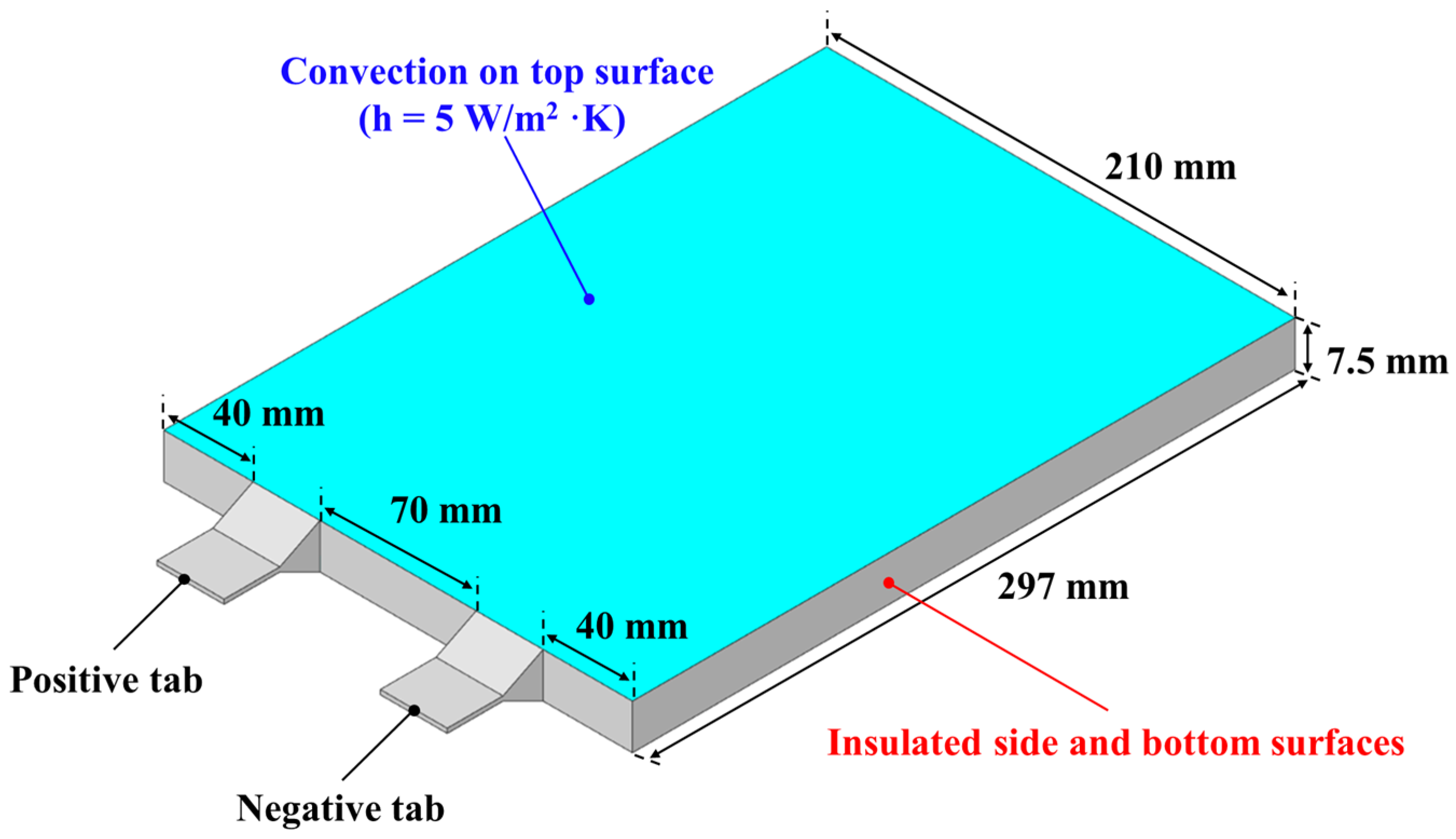
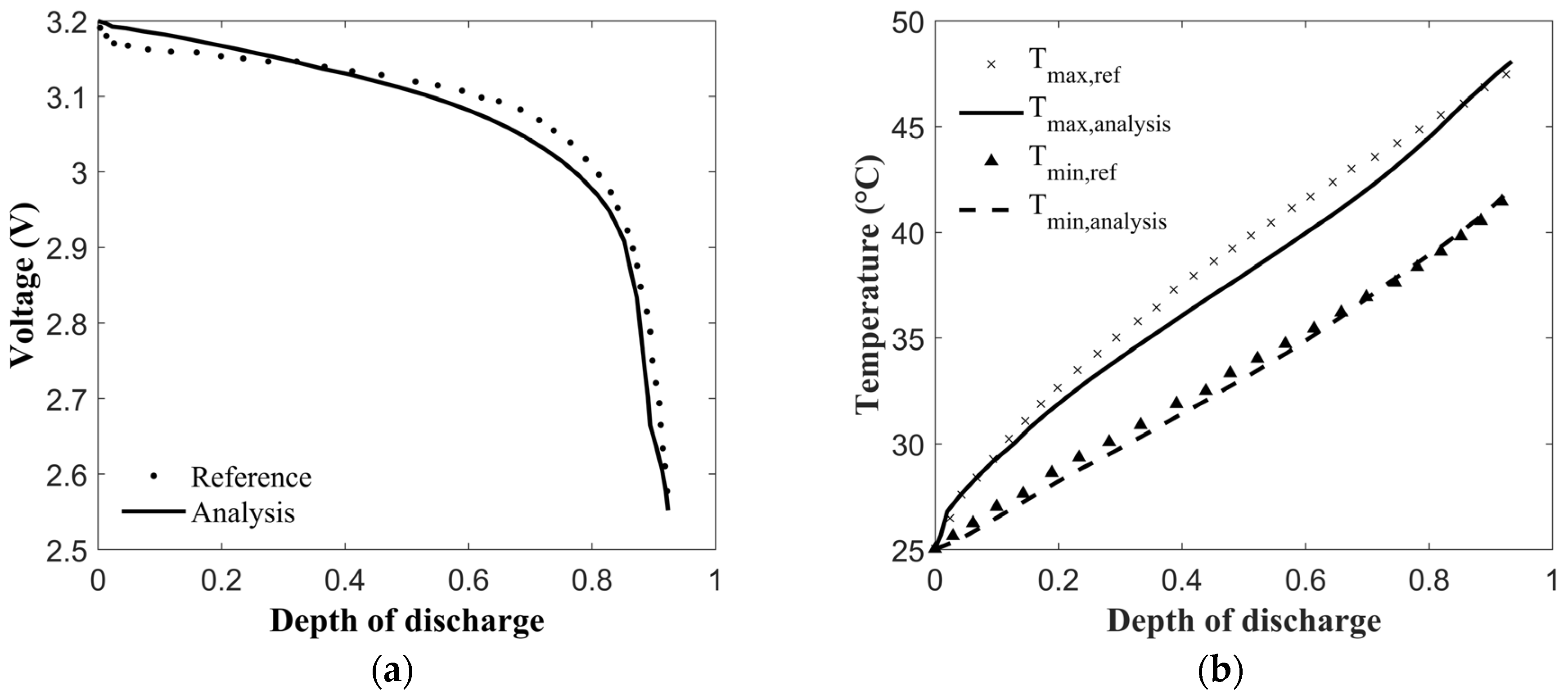
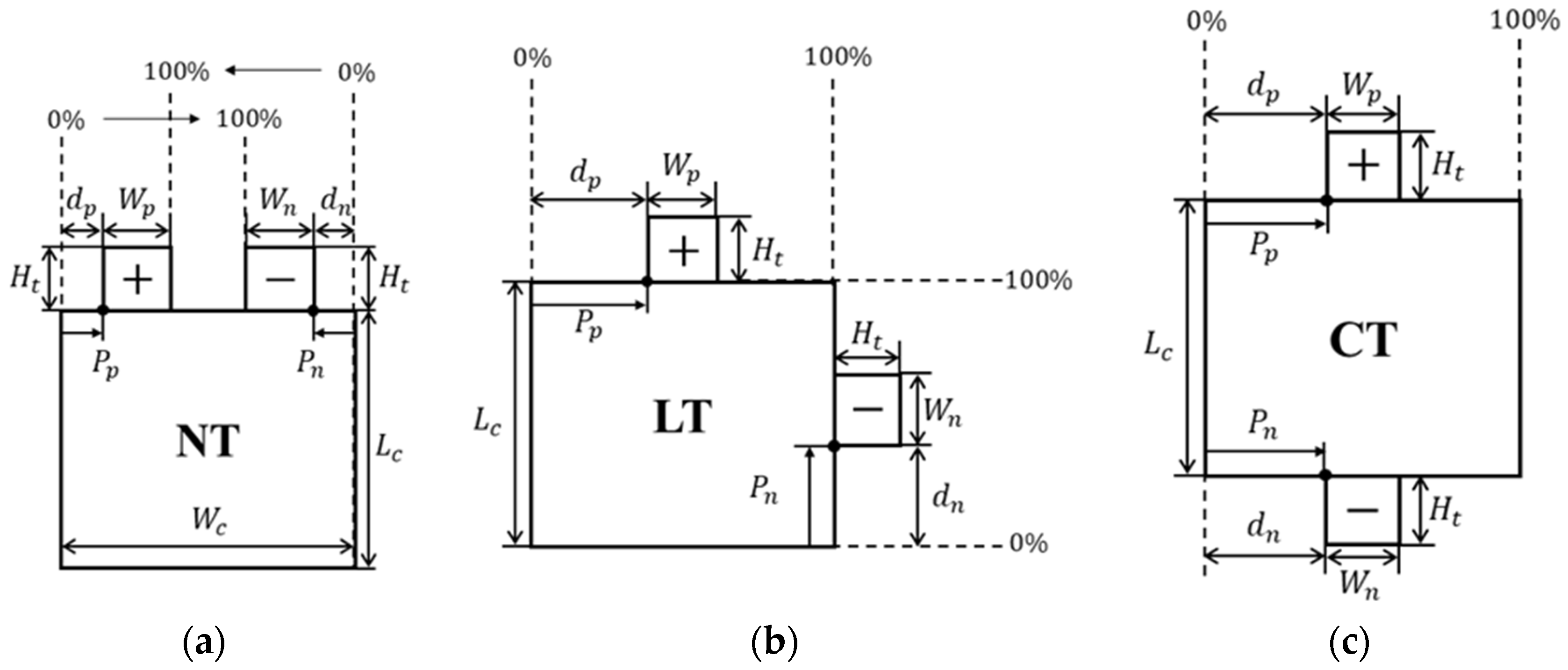
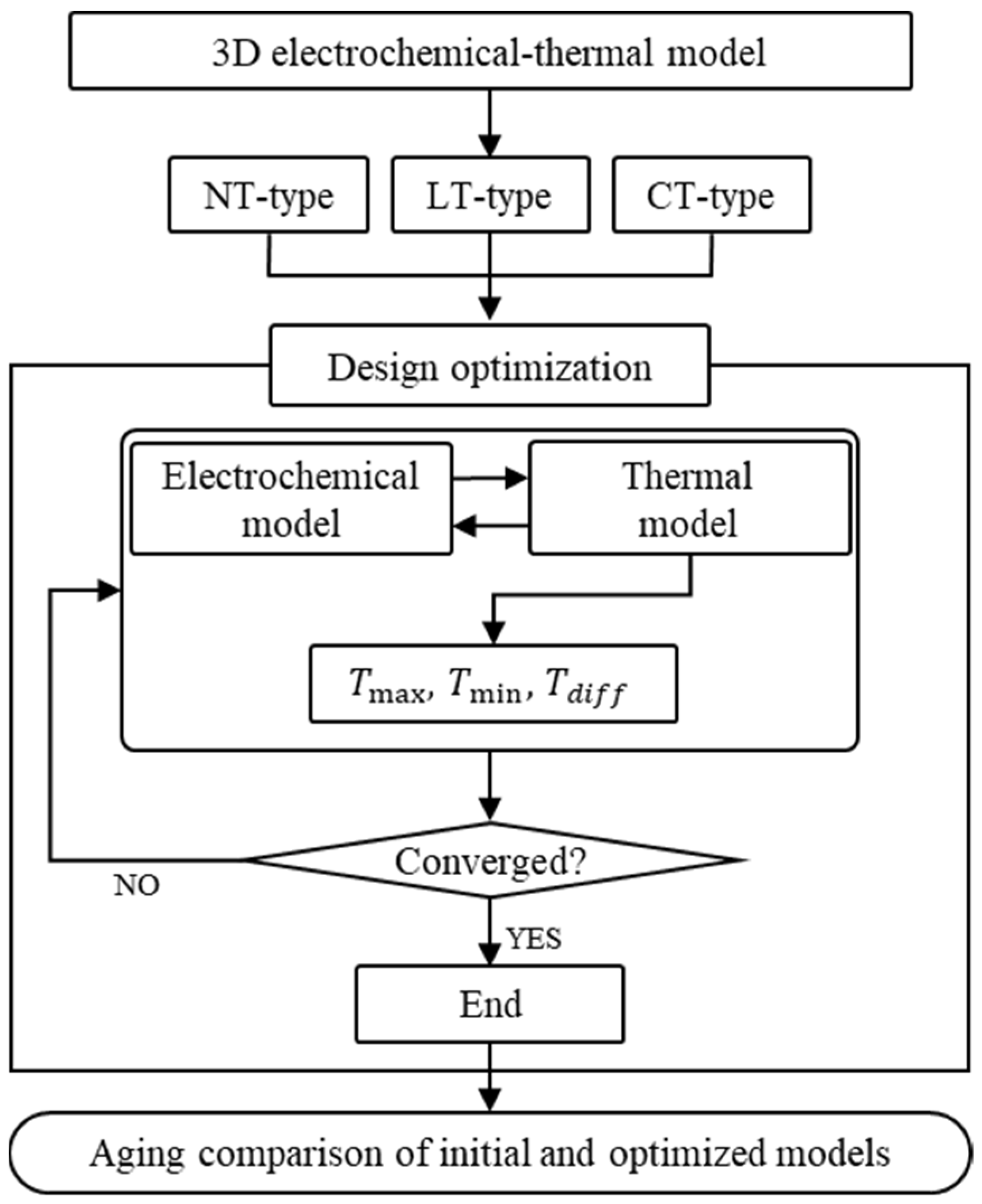

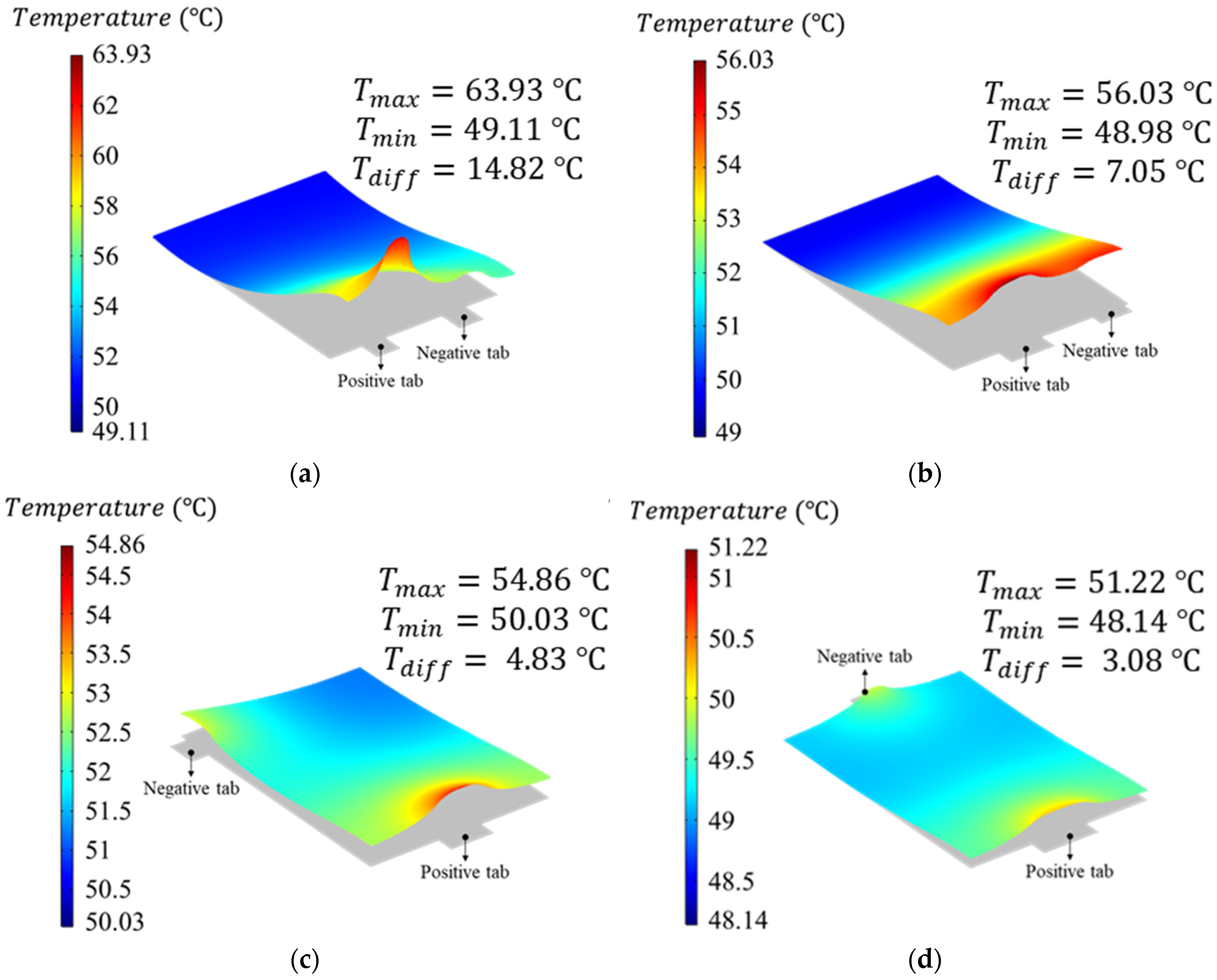
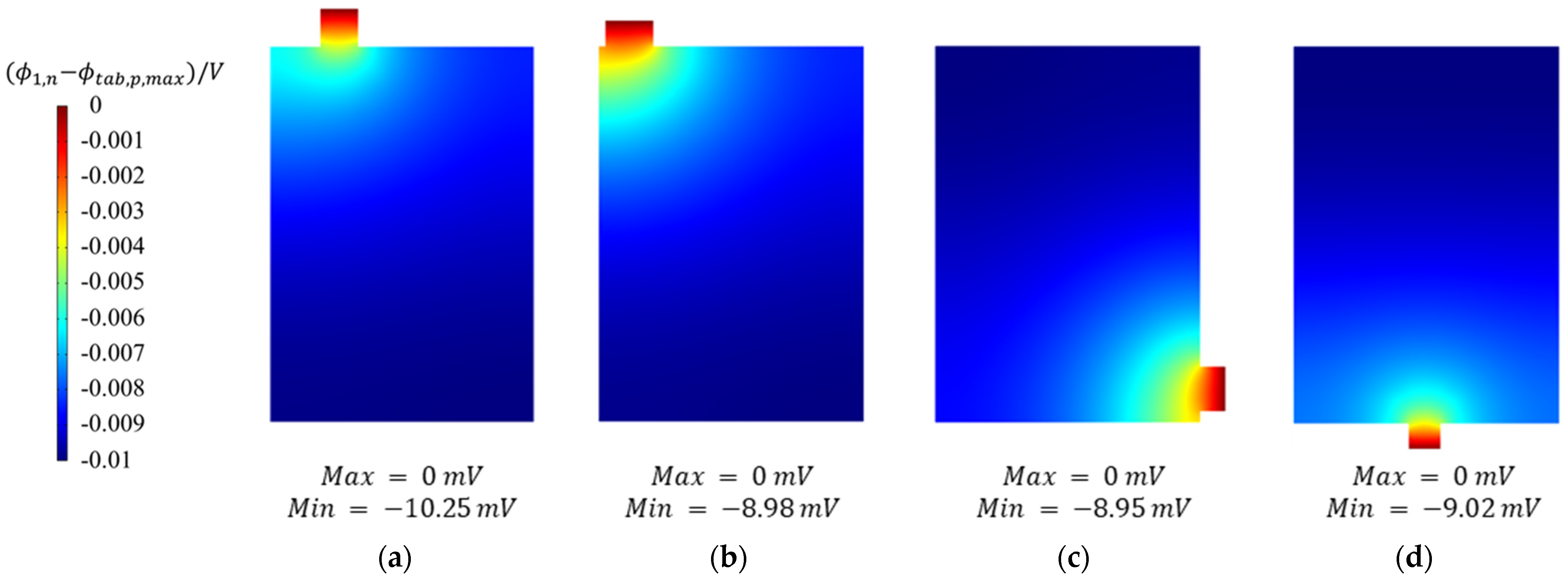

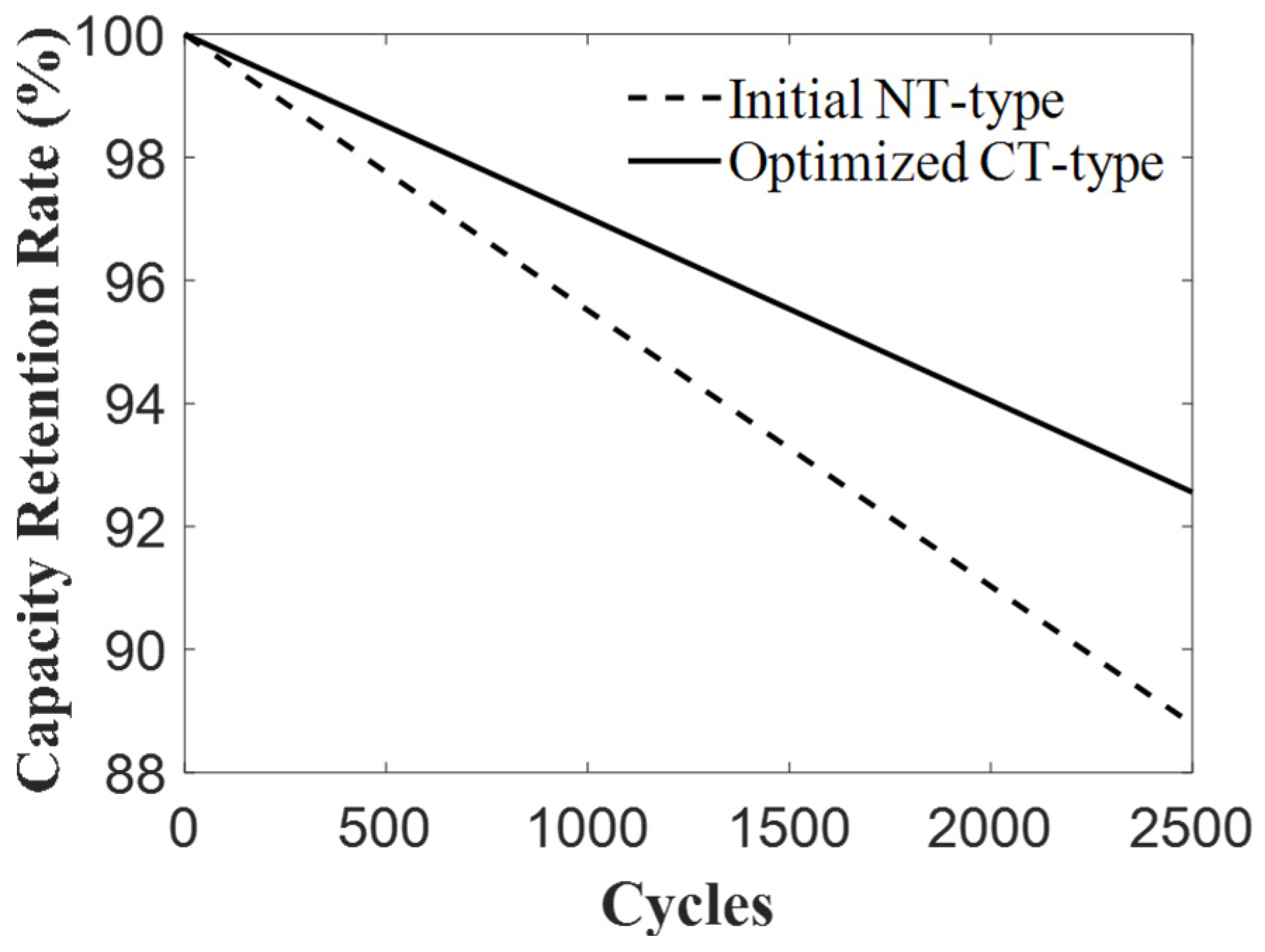
| Parameter | Negative Electrode | Separator | Positive Electrode |
|---|---|---|---|
| Diffusion coefficient (m2/s) | 4.0 × 10−10 | - | 6.5 × 10−18 |
| Thickness | 67.7 | 25 | 76 |
| Solid-phase conductivity (S/m) | 100 | - | 11.8 |
| Reaction rate constant (m/s) | 3.5 × 10−11 | - | 5.5 × 10−12 |
| Charge transfer coefficient | 0.5 | - | 0.5 |
| Electrolyte-phase volume | 0.341 | 0.31 | 0.31 |
| Maximum solid-phase concentration (mol/m3) | 30,555 | - | 23,000 |
| Electrolyte diffusion coefficient (m2/s) | 3.0 × 10−10 | ||
| Initial electrolyte salt concentration (mol/m3) | 1000 | ||
| Heat transfer coefficient on the top surface (W/m2 K) | 5 | ||
| Atmosphere temperature (K) | 298 | ||
| Parameter | Value | ||
| Cell width (mm) | 210 | ||
| Cell height (mm) | 297 | ||
| Cell thickness (mm) | 7.5 | ||
| Tab width (mm) | 3.0 | ||
| Tab height (mm) | 3.0 | ||
| Nominal capacity (Ah) | 55 | ||
| Nominal voltage (V) | 3.2 | ||
| Cutoff voltage (V) | 2.5 | ||
| Design Variables | Lower Boundary | Upper Boundary |
|---|---|---|
| ( | 0 (%) | 100 (%) |
| ( | 0 (%) | 100 (%) |
| ( | 1 (cm) | 9 (cm) |
| ( | 1 (cm) | 9 (cm) |
| () | 2 (cm) | 3.5 (cm) |
| Design Variable | Initial NT Type | Optimized NT Type | Optimized LT Type | Optimized CT Type |
| 26.19 | 43.61 | 50.00 | 50.00 | |
| 26.19 | 7.568 | 3.42 | 49.27 | |
| 3.00 | 5.00 | 5.00 | 6.50 | |
| 3.00 | 3.79 | 3.50 | 2.50 | |
| 3.00 | 2.05 | 2.00 | 2.00 | |
| Response (°C) | Initial NT Type | Optimized NT Type | Optimized LT Type | Optimized CT Type |
| 63.93 | 56.03 | 54.86 | 51.22 | |
| 49.11 | 48.98 | 50.03 | 48.14 | |
| 14.82 | 7.05 | 4.83 | 3.08 |
Disclaimer/Publisher’s Note: The statements, opinions and data contained in all publications are solely those of the individual author(s) and contributor(s) and not of MDPI and/or the editor(s). MDPI and/or the editor(s) disclaim responsibility for any injury to people or property resulting from any ideas, methods, instructions or products referred to in the content. |
© 2023 by the authors. Licensee MDPI, Basel, Switzerland. This article is an open access article distributed under the terms and conditions of the Creative Commons Attribution (CC BY) license (https://creativecommons.org/licenses/by/4.0/).
Share and Cite
Lee, J.; Chang, H.; Kim, C.-W. Optimization of LFP Pouch Cell Tab Design for Uniform Temperature Distribution. Mathematics 2023, 11, 1970. https://doi.org/10.3390/math11081970
Lee J, Chang H, Kim C-W. Optimization of LFP Pouch Cell Tab Design for Uniform Temperature Distribution. Mathematics. 2023; 11(8):1970. https://doi.org/10.3390/math11081970
Chicago/Turabian StyleLee, Jun, Hyukkyun Chang, and Chang-Wan Kim. 2023. "Optimization of LFP Pouch Cell Tab Design for Uniform Temperature Distribution" Mathematics 11, no. 8: 1970. https://doi.org/10.3390/math11081970
APA StyleLee, J., Chang, H., & Kim, C.-W. (2023). Optimization of LFP Pouch Cell Tab Design for Uniform Temperature Distribution. Mathematics, 11(8), 1970. https://doi.org/10.3390/math11081970







